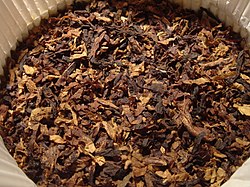Passive smoking
Health effects of involuntary inhalation of tobacco smoke

Passive smoking, also known as secondhand smoke, refers to the involuntary inhalation of smoke by non-smokers who are in the vicinity of active smokers. This smoke is a combination of "sidestream smoke" from the burning end of a cigarette, cigar, or pipe, and "mainstream smoke" exhaled by the smoker. Passive smoking is a significant public health concern due to its association with various health risks.
Health Effects[edit]
Passive smoking has been linked to numerous health problems in both adults and children. In adults, it increases the risk of coronary heart disease, stroke, and lung cancer. In children, exposure to secondhand smoke is associated with sudden infant death syndrome (SIDS), asthma, respiratory infections, and ear infections.
Cardiovascular Disease[edit]
Exposure to secondhand smoke can lead to the development of cardiovascular diseases. It is estimated that passive smoking increases the risk of heart disease by 25-30% in non-smokers. The chemicals in tobacco smoke can damage the lining of blood vessels, leading to atherosclerosis and increased risk of heart attacks.
Respiratory Problems[edit]
Secondhand smoke is a known cause of lung cancer in non-smokers. It contains over 7,000 chemicals, many of which are toxic and at least 70 are known to cause cancer. In addition to lung cancer, passive smoking can exacerbate asthma and lead to chronic obstructive pulmonary disease (COPD).
Effects on Children[edit]
Children are particularly vulnerable to the effects of passive smoking. Exposure can lead to a range of health issues, including increased frequency and severity of asthma attacks, respiratory infections, and a higher risk of developing lung cancer later in life.

Prevention and Legislation[edit]
Many countries have implemented smoking bans in public places to reduce exposure to secondhand smoke. These bans have been shown to decrease the incidence of heart attacks and improve public health outcomes. Public awareness campaigns also play a crucial role in educating the public about the dangers of passive smoking.
Measurement of Exposure[edit]
Exposure to secondhand smoke can be measured using various methods, including the detection of nicotine or cotinine (a metabolite of nicotine) in the blood, saliva, or urine. Breath carbon monoxide (CO) monitors can also be used to assess exposure levels.

Also see[edit]
| Tobacco |
|---|
|
|
Ad. Transform your life with W8MD's Budget GLP-1 injections from $75


W8MD offers a medical weight loss program to lose weight in Philadelphia. Our physician-supervised medical weight loss provides:
- Weight loss injections in NYC (generic and brand names):
- Zepbound / Mounjaro, Wegovy / Ozempic, Saxenda
- Most insurances accepted or discounted self-pay rates. We will obtain insurance prior authorizations if needed.
- Generic GLP1 weight loss injections from $75 for the starting dose.
- Also offer prescription weight loss medications including Phentermine, Qsymia, Diethylpropion, Contrave etc.
NYC weight loss doctor appointmentsNYC weight loss doctor appointments
Start your NYC weight loss journey today at our NYC medical weight loss and Philadelphia medical weight loss clinics.
- Call 718-946-5500 to lose weight in NYC or for medical weight loss in Philadelphia 215-676-2334.
- Tags:NYC medical weight loss, Philadelphia lose weight Zepbound NYC, Budget GLP1 weight loss injections, Wegovy Philadelphia, Wegovy NYC, Philadelphia medical weight loss, Brookly weight loss and Wegovy NYC
|
WikiMD's Wellness Encyclopedia |
| Let Food Be Thy Medicine Medicine Thy Food - Hippocrates |
Medical Disclaimer: WikiMD is not a substitute for professional medical advice. The information on WikiMD is provided as an information resource only, may be incorrect, outdated or misleading, and is not to be used or relied on for any diagnostic or treatment purposes. Please consult your health care provider before making any healthcare decisions or for guidance about a specific medical condition. WikiMD expressly disclaims responsibility, and shall have no liability, for any damages, loss, injury, or liability whatsoever suffered as a result of your reliance on the information contained in this site. By visiting this site you agree to the foregoing terms and conditions, which may from time to time be changed or supplemented by WikiMD. If you do not agree to the foregoing terms and conditions, you should not enter or use this site. See full disclaimer.
Credits:Most images are courtesy of Wikimedia commons, and templates, categories Wikipedia, licensed under CC BY SA or similar.
Translate this page: - East Asian
中文,
日本,
한국어,
South Asian
हिन्दी,
தமிழ்,
తెలుగు,
Urdu,
ಕನ್ನಡ,
Southeast Asian
Indonesian,
Vietnamese,
Thai,
မြန်မာဘာသာ,
বাংলা
European
español,
Deutsch,
français,
Greek,
português do Brasil,
polski,
română,
русский,
Nederlands,
norsk,
svenska,
suomi,
Italian
Middle Eastern & African
عربى,
Turkish,
Persian,
Hebrew,
Afrikaans,
isiZulu,
Kiswahili,
Other
Bulgarian,
Hungarian,
Czech,
Swedish,
മലയാളം,
मराठी,
ਪੰਜਾਬੀ,
ગુજરાતી,
Portuguese,
Ukrainian
